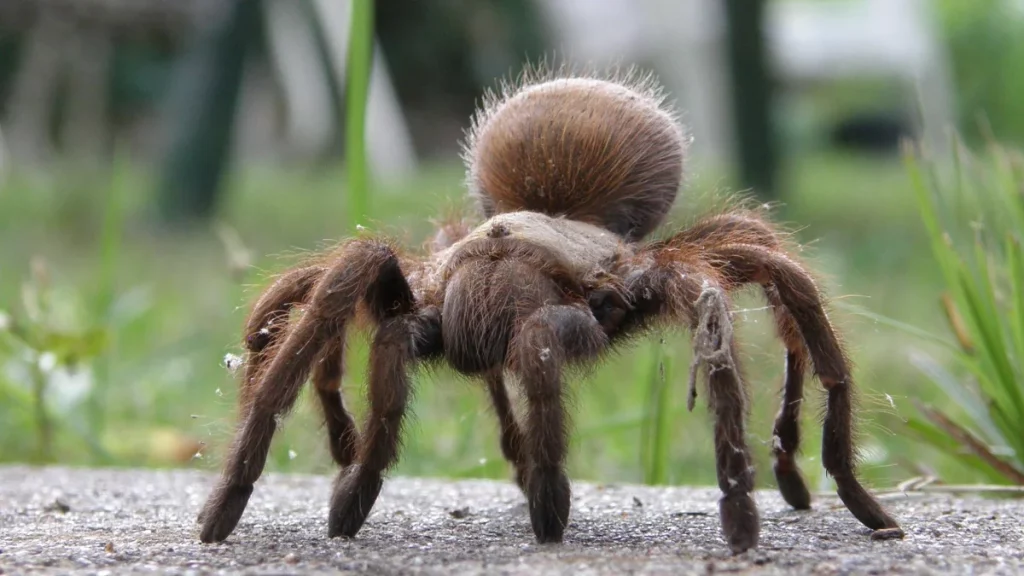Tarantulas are a kind of nocturnal predator spider. So, I understand your urge to understand their nature absolutely. Especially their jumping ability! Can tarantulas jump?
If you are confused about if it’s a myth or truth, you have come to the right place! Here I will unlock the secret.
Yes, my answer to the question is tarantulas can jump. Though they can’t jump too high like other animals, they can jump for a couple of inches easily. Not all of them can jump. For instance, Terrestrial tarantulas are usually unable to jump. But, If you have got a Texas tarantula as your pet, you might have seen it take a leap with bursts of speed. And, it’s absolutely normal.
Why and When Does a Tarantula Jump?
Tarantulas tend to live in forest-like areas and are good jumpers. It has to get its food by predating other little species. They have evolved to move and run fast, even sometimes bouncing forward or high to catch their animals.
But if you got a pet and have its food just ready before it, yet your tarantula jumps out suddenly, it might have felt threatened by something or want to avoid humans.
This little creature is fast to react. And their taking a leap forward is just the reaction to something that made it feel endangered. What I will suggest to make your pet spider feel safe is not to play with it unnecessarily. Let it play around its enclosure.
It can also happen sometimes that your tarantula is exploring new territory that you got for him. It increases their chances of reproduction especially for female tarantulas.
Thus, bouncing and jumping don’t necessarily need to be in a pessimistic way. Probably your tarantula is just happy to expand its range.
How Far Can a Texas Tarantula Jump?

Texas tarantula is one of the most common types of tarantula found in the southern part of the USA.
Depending on a tarantula’s size, shape, and body, it jumps at different distances. So, far a Texas tarantula has been seen bouncing forward up to 20 inches (approximately).
It’s not the exact measure but it’s close to the accurate distance. If your tarantula has never been in the wild and was born and grown up in phony habitats, it will probably jump forward around 1 to 8 inches.
I want to share one thing must. If a tarantula with a weak abdomen and exoskeleton jumps, it can lead to death. So, don’t make it jump every now and then.
Can Tarantulas Jump? How High Predator Tarantulas Jump?
Predator tarantulas are capable of jumping with their hind legs. A small-size tarantula can jump at short distances like nearly 5 inches and a big-size tarantula can jump at a long distance — nearly 10 inches.
It’s an interesting fact that they don’t face any difficulties with what kind of surface it is. They move and run very smoothly on glass-like surfaces too.
You might have heard that a tarantula may have the skill of jumping quite up to 20 inches. That’s not completely a lie. There are 400 types of tarantulas in the wild living around the world. One of them is called the Bird-eating tarantula. These can jump really high to catch prey and escape predators.
Can Baby Tarantulas Move or Jump?
Yes, baby tarantulas are capable of moving and jumping. Their movement patterns and abilities depend on the types of their species.
Their movements are generally slower and less coordinated compared to mature tarantulas. Some species of baby tarantulas, especially those that are arboreal (tree-dwelling tarantulas) or semi-arboreal species with blue fang, may show more noticeable climbing abilities.
I love it when my cute tarantulas try to make short leaps with their pink toes. I feel like it is relieving my stress. They grew up and developed over time, and their behavior has been changed also. Still, I love their playfulness.
Can My Pet Spider Jump Out of Their Enclosure?

Generally, a pet spider doesn’t jump that much. They are truly docile and rely on mostly crawling or climbing.
Whether your pet tarantula is going to jump out of its enclosure or not, depends on a few factors, such as the security of the enclosure, the spider’s size, and physical abilities.
If the enclosure is secure and suitable, you can minimize the risk of your pet’s escaping. It’s noteworthy that most pets don’t actively try to escape by jumping out. Still, it’s better to take some precautions.
I will share 5 useful suggestions and guides so that you can provide your exotic pets with a secure enclosure.
1. Enclosure Design
Different species of spiders have different living styles. For example, some species of tarantula reside in burrows woven by them. So, design an enclosure that suits your tarantula.
Adjust or design the space, substrate, and environmental conditions according to your tarantula’s living habits. On that note, you can take advice from professionals. Besides, you can also conduct a bit of research on their habitat. This way things become way easier.
2. Ventilation and gap
Make sure that your pet’s enclosure has proper ventilation and gap. The small opening will let the airflow. Don’t create too big a gap, otherwise, your spider will try to escape it away.
3. Lid security
As you know that tarantulas also jump vertically. Make sure the lid is secured properly. Arboreal tarantula are skilled climbers.
They might try to push open or lift the lid in order to escape. You can use a heavy lid or cover for the enclosure. This little creature can’t push a heavy lid easily.
4. Substrate depth
Does your spider require substrate? On that note, make the substrate deep enough. In this way, it will prevent your tarantula from reaching the top of the enclosure. So, your pet won’t be able to jump and escape.
5. Regular inspection
There is no alternative to regular inspection. Check and inspect the enclosure after a certain period of time. If you find any loose mesh or damaged hinges, fix it right away.
I check my spider’s enclosure every alternate day. It helps me to stay aware of the entire situation and prevent any potentially risky situation.
Wrap-up
Species like Tarantulas are not aggressive. But when you tease them or make feel them disturbed, they might try to jump and bite you. Tarantulas are not poisonous. Still, they have some toxic venom that helps them to paralyze their prey.
So, it’s better for you to stay aware and not get bitten. What you have to do is keep their enclosure relaxing and make them feel relaxed. Rest assured! They won’t be able to jump distances of nearly 2 feet in the air.



